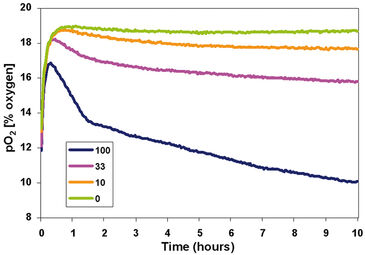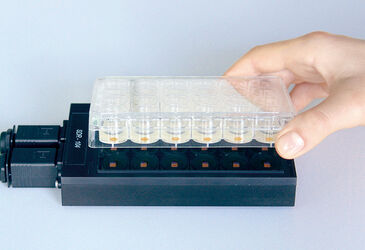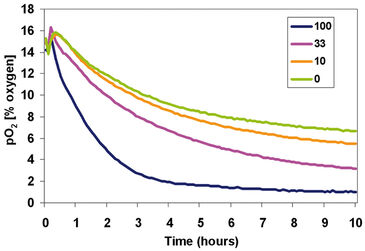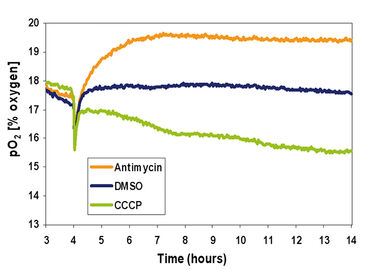Watch tutorials, webinars and informative videos about PreSens optical sensor systems.
Online Oxygen Monitoring in Cell Culture
Effects of mitochondrial modulators on O2 dynamics of mammalian cells
Lynn S. G. and LaPres J. J.
Dept. of Biochemistry, Michigan State University, East Lansing, MI, USA
Real-time measurements of oxygen and pH in mammalian cell cultures are important to understand the metabolic dynamics in cell cultures. The SDR SensorDish® Reader allows the time course of cellular oxygen consumption to be followed in response to environmental conditions or toxicological insults. This type of monitoring could also be valuable for other applications such as tissue engineering and stem cell research.
The SDR SensorDish® Reader (Fig. 1) enables non-invasive online monitoring of oxygen and pH in 24-well microtiter plates. In the present work, the SDR was utilized to monitor oxygen levels in the media of cells plated at 4 different cell densities and varying oxygen tension (19 % O2 (Fig. 2) and 7 % O2 (Fig. 3)). In addition, the O2 consumption rates in response to mitochondrial modulators (Fig. 4) were also assessed. Mouse embryonic fibroblasts (MEFs) were used as a representative mammalian cell type, carbonyl cyanide m-chlorophenylhydrazone (CCCP) was used as a metabolic uncoupler and antimycin was used as an electron transport chain inhibitor.
Materials & Methods
Mouse embryonic fibroblast (MEF) cells were grown in 24-well multidishes with integrated oxygen sensors (OxoDishes®). Cells were maintained in Dulbeco's Modified Eagle Medium (DMEM) supplemented with 10 % heat inactivated fetal bovine serum (FBS), 1 % penicillin (10,000 U/ml)/streptomycin (10,000 µg/ml), 1 % L-glutamine (200 mM), 1 % non-essential amino acids (10mM) and 1 % 1M HEPES (pH 7.8) under standard cell culture conditions (5 % CO2, 35 % humidity and 37 °C). In all cases, cells were grown in 1 ml of media / well in a Coy O2 Controlled Glove Box. The oxygen concentration in the culture medium was monitored throughout the culture period at preset intervals using the SensorDish® Reader software.

Effects of Cell Density
The first experiment was designed to investigate the effects of cell density on the cellular oxygen consumption rate and subsequent pO2 levels in the media. MEF cells were plated at three separate concentrations (100,000; 33,000; and 10;000 cells / cm2) along with a "media only" control. Measurements were made every 2 minutes for 10 hours at near atmospheric oxygen levels (approx. 19 % O2). The oxygen profile (Fig. 2) clearly shows an effect of cell density on the O2 consumption level of each treatment. A lag period of < 1 hour is observed, presumably where the system is equilibrating to temperature and oxygen levels. After this period, all the cell concentrations show a decrease in pO2 levels from the "media only" control wells. Finally, during the course of the incubation, the deviation from the "media only" control wells is proportional to the number of cells initially plated, implying that individual cellular respiration is equivalent at all the cell densities tested.
The second experiment was designed to investigate the effects of low ambient oxygen levels on cell density- induced observations in the first experiment. MEF cells were plated at three seperate concentrations (100,000; 33,000, and 10,000 cells / cm2) along with a "media only" control and then placed in a 7 % O2 atmosphere and monitored every 5 minutes for 10 hours. The oxygen profile confirmed the effect of cell density on the O2 consumption level of each treatment (Fig. 3). A short period of temperature equilibration (< 1 hour) is observed, after which the residual oxygen in the media is consumed by the cells in a density dependent fashion. Interestingly, even the "media only" is not fully equilibrated at the new oxygen levels at 7 % O2 after 10 hours. However, the deviation from the "media only" control wells by each treatment is proportional to the number of cells plated.
Effects of Mitochondrial Modulators
The third experiment was designed to investigate the effects of specific mitochondrial modulators on the cellular oxygen consumption and subsequent pO2 levels in the media. MEF cells were plated at 33,000 cells / cm2 and allowed to adhere to the culture dish for 4 hours. The culture media was then replaced with the treatment specific media, containing either 1 µl/ml dimethyl sulfoxide (DMSO, vehicle control); 10 µM carbonyl cyanide m-chlorophenylhydrazone (CCCP); or 10 µM antimycin. Each well was then topped with 1 ml of mineral oil and the plate was incubated under standard culture conditions (5 % CO2, 35 % humidity, 37 °C, and 19 % O2 atmosphere) and monitored every 2 minutes for 10 hours. The oxygen profile shows a pronounced effect of treatment on the O2 consumption level of the cells (Fig. 4). Measurements from the 3 to 4 hour time points indicate that there was little variation in the treatments prior to receiving the dosed media. Within 30 minutes of dosing, observable differences emerged in the oxygen consumption curves between the treatments. DMSO, the vehicle control, caused little variation in the average O2 level in the MEF cells. A steady state between oxygen consumption and oxygen ingress was formed at about 17.5 % O2. Antimycin, an inhibitor of Complex III of the electron transport chain, showed an observable decrease in the oxygen consumption rate of the cells, resulting in a steady state higher than the one with DMSO. Finally, CCCP, a mitochondrial uncoupler, treatment resulted in an observable increase in cellular oxygen consumption.
Conclusion
Using the SDR SensorDish® Reader, we monitored media oxygen levels in mammalian cell cultures and showed a cell density dependent oxygen consumption. The density dependent differences observed at 19 % O2 were also observed at 7 % O2, a more physiologically relevant oxygen level. In addition, cell culture media with no cells took more than 10 hours to reach equilibrium when exposed to 7 % O2. Therefore, preincubation of the medium at the desired oxygen level is recommended. Finally, CCCP was observed to increase cellular oxygen demand while antimycin was observed to decrease cellular oxygen demand compared to the vehicle control. The SDR SensorDish® Reader allows for constant and rapid quantification of media oxygen levels which can be used as a measure of cellular oxygen demand and metabolic function.





